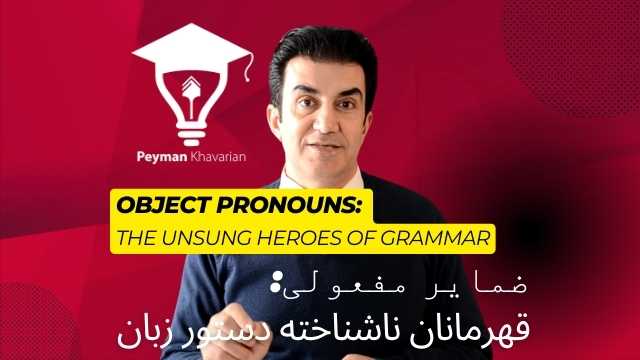Object Pronouns: The Unsung Heroes of Grammar ضمایر مفعولی: قهرمانان ناشناخته دستور زبان

Object Pronouns: The Unsung Heroes of Grammar
In the grand theater of English grammar, object pronouns are the understudies that take the stage when the main nouns need a break. They’re not the stars of the sentence, but without them, the show just wouldn’t go on smoothly.
What Are Object Pronouns? Object pronouns are the stunt doubles for nouns when they’ve done enough heavy lifting in a sentence. They include me, you, him, her, it, us, and them. These pronouns are used when referring to people, animals, and things1.
Direct Object Pronouns: The Direct Hit When a verb throws a ball, the direct object pronoun is there to catch it. It answers the questions “What?” or “Whom?” after an action verb. For example:
- She saw him. (Who did she see? Him!)
- He ate it. (What did he eat? It!)
- They called us. (Who did they call? Us!)
Indirect Object Pronouns: The Middlemen These pronouns are the middlemen of the sentence, passing the action from the verb to the direct object. They’re the ones who get the action indirectly. For instance:
- I gave her the book. (To whom did I give the book? Her!)
Object of Preposition: The Followers These pronouns will follow prepositions around like loyal puppies. They’re always used after prepositions to tell us more about the action. For example:
- We’ll sit near him. (Near whom? Him!)
- This whole pizza is for us. (For whom? Us!)
Subject Pronouns vs. Object Pronouns: The Face-off While subject pronouns like I, you, he, she, it, we, and they bask in the spotlight as the subjects of sentences, object pronouns wait in the wings, ready to take their place as objects. They’re not jealous, though; they know every pronoun has its role to play2.
Examples in Action:
- She gave him the gift. (Here, she is the subject pronoun doing the giving, and him is the object pronoun receiving the gift.)
- They saw us at the park. (In this scene, they are the subject pronouns doing the seeing, and us are the object pronouns being seen.)
Conclusion: Object pronouns may not get the glory, but they’re essential to keeping our sentences from sounding like broken records. They step in, take the hit, and keep the conversation flowing. So next time you use one, give a little nod to these unsung heroes of grammar.
ضمایر مفعولی: قهرمانان ناشناخته دستور زبان
در تئاتر بزرگ دستور زبان انگلیسی، ضمایر مفعولی همانند بازیگران جانشین هستند که وقتی اسمهای اصلی به استراحت نیاز دارند، به صحنه میآیند. آنها ستارههای جمله نیستند، اما بدون آنها، نمایش به خوبی پیش نمیرود.
ضمایر مفعولی چیستند؟ ضمایر مفعولی دوبلورهایی برای اسمها هستند وقتی که آنها کافی کار کردهاند در یک جمله. آنها شامل من، تو، او (مذکر)، او (مونث)، آن، ما و آنها میشوند. این ضمایر زمانی استفاده میشوند که به افراد، حیوانات و چیزها اشاره میکنیم.
ضمایر مفعولی مستقیم: ضربه مستقیم وقتی فعل یک توپ پرتاب میکند، ضمیر مفعولی مستقیم آنجاست تا آن را بگیرد. این ضمایر به سوالات “چه چیزی؟” یا “چه کسی؟” پس از یک فعل عملی پاسخ میدهند. برای مثال:
- او او را دید. (او چه کسی را دید؟ او!)
- او آن را خورد. (او چه چیزی را خورد؟ آن!)
- آنها ما را صدا زدند. (آنها چه کسی را صدا زدند؟ ما!)
ضمایر مفعولی غیرمستقیم: واسطهها این ضمایر واسطههای جمله هستند، که عمل را از فعل به مفعول مستقیم منتقل میکنند. آنها کسانی هستند که عمل را به صورت غیرمستقیم دریافت میکنند. برای مثال:
- من او را کتاب دادم. (من به چه کسی کتاب دادم؟ او!)
ضمایر مفعولی پس از حرف اضافه: دنبالکنندگان این ضمایر مثل سگهای وفادار پشت سر حروف اضافه راه میروند. آنها همیشه پس از حروف اضافه استفاده میشوند تا به ما در مورد عمل بیشتر بگویند. برای مثال:
- ما نزدیک او خواهیم نشست. (نزدیک چه کسی؟ او!)
- این پیتزای کامل برای ما است. (برای چه کسی؟ ما!)
ضمایر فاعلی در مقابل ضمایر مفعولی: رویارویی در حالی که ضمایر فاعلی مثل من، تو، او، ما و آنها در نورافکن به عنوان فاعلهای جملات قرار دارند، ضمایر مفعولی در پشت صحنه منتظر هستند تا جایگزین آنها شوند. آنها حسادت نمیکنند، زیرا میدانند هر ضمیری نقش خود را دارد.
مثالهای عملی:
- او به او هدیه داد. (در اینجا، او ضمیر فاعلی است که عمل دادن را انجام میدهد، و او ضمیر مفعولی است که هدیه را دریافت میکند.)
- آنها ما را در پارک دیدند. (در این صحنه، آنها ضمایر فاعلی هستند که عمل دیدن را انجام میدهند، و ما ضمایر مفعولی هستند که دیده میشوند.)
نتیجهگیری: ضمایر مفعولی شاید افتخار نگیرند، اما برای جلوگیری از تکراری شدن جملات ما ضروری هستند. آنها وارد میشوند، ضربه را میگیرند و گفتگو را جاری نگه میدارند. پس دفعه بعد که از یکی از آنها استفاده کردید، به این قهرمانان ناشناخته دستور زبان ادای احترام کنید







دیدگاهتان را بنویسید